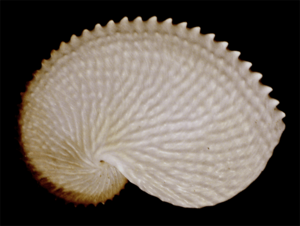Knobby Argonaut facts for kids
Quick facts for kids Knobby Argonaut |
|
|---|---|
 |
|
| Eggcase of Argonauta nodosus | |
| Conservation status | |
| Scientific classification | |
| Synonyms | |
|
The Argonauta nodosus, also called the knobby argonaut, is a special type of octopus that lives in the open ocean. It's known for its unique, paper-thin shell. Only the female argonauts make this shell. It wraps around her body, much like a nautilus lives in its shell. This is why they are sometimes called "paper nautiluses."
The shell of the knobby argonaut is usually about 150 millimeters (about 6 inches) long. Some very large ones can be over 250 millimeters (nearly 10 inches) long. The biggest one ever found was 292 millimeters (about 11.5 inches) long! This shell has many small bumps, or "nodules," on its ridges. These bumps give the argonaut its name, nodosus, which means "knobby." Younger females might have fewer or no bumps on their shells.
Contents
What is a Knobby Argonaut?
The female knobby argonauts can grow quite large, up to 100 millimeters (about 4 inches) in mantle length. Their total length, including arms, can reach 300 millimeters (about 12 inches). Male argonauts are much smaller, usually no more than 40 millimeters (about 1.5 inches) long.
This species has special webbed arms covered in many chromatophores. These are cells that can change color quickly. Scientists have seen these webs change from a deep maroon red to a shiny silver very fast. This helps them blend in or surprise prey.
Scientists have also noticed something interesting about their eggs. The eggs laid by A. nodosus in southern Australia are often found in three different groups. Each group has eggs that are at a similar stage of development. This suggests they might lay eggs in batches.
Where Do Knobby Argonauts Live?
The knobby argonaut lives in a wide area, including the Indo-Pacific region and the eastern coast of South America. They are most commonly found in southern Australia, New Zealand, and South Africa. You'll only find them in the Southern Hemisphere.
Sometimes, many knobby argonauts wash up on beaches in South Africa and southern Australia. These mass strandings happen at certain times of the year, usually between April and August. This is often near the end of their egg-laying season.
What Do Knobby Argonauts Eat?
Knobby argonauts mostly eat other molluscs that live in the open ocean. When kept in tanks, female argonauts have been seen eating dead prawns and fish.
Many animals also hunt the knobby argonaut. They have been found in the stomachs of large deep-sea fish called Alepisaurus ferox. Knobby argonauts are also a food source for Australian fur seals in places like the Bass Strait and southern Tasmania.
Knobby Argonauts and People
In the traditional Māori culture of New Zealand, the knobby argonaut (which they call pūpu tarakihi) is a special symbol. Its shape looks like a koru, which is an unfurling fern frond. The koru represents new growth and rebirth in Māori art.
Knobby argonauts are part of many traditional Māori stories. One famous story is a waiata (song) called "He Ata te Hau." This song tells about a dream that a Ngāti Whātua tohunga (expert or priest) named Tītahi had. He dreamed of many white knobby argonauts washing ashore, pushed by the north wind. This dream was later seen as a prophecy, or prediction, of Europeans arriving in New Zealand.
Images for kids
-
A beached A. nodosus found at Port Phillip, Australia






